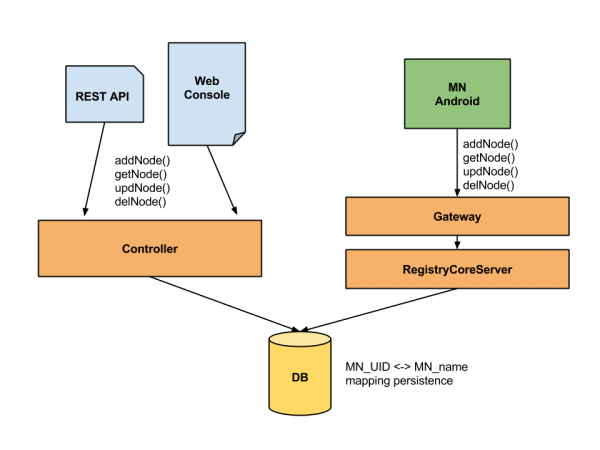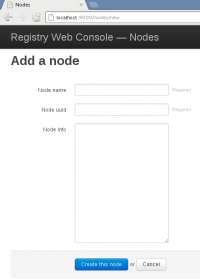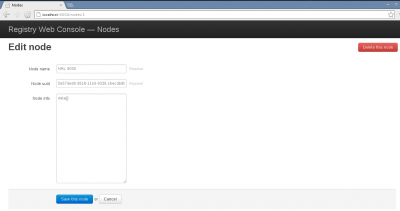Table of Contents
Registry Service
Mobile nodes Registry service, offering a RegistryCoreServer to talk with mobile clients, a Web Console interface to manage nodes with a web browser, and a REST API to exchange JSON data with other servers or clients.
The main objective of this service is to provide UUID to label mapping and vice-versa. This way you can map long and near-to-impossible to remember UUID strings to friendly names like an e-mail, a car plate, a proper noun, nickname, username or any other label you need.
Architecture
Screenshots
Web Console Interface screenshots for basic Admin operations. This is a CRUD interface.
CRUD stands for Create, Retrieve, Update, Delete (as in managing objects/entries in a database with a simple user interface, usually web based).
- Adding a node.
- Editing a node.
- Listing nodes.
REST API
REST API services HTTP clients and helps them to manage nodes in the database from outside the Java server or client code, by making HTTP calls to predefined service routes.
POST /api/nodesCreate nodeGET /api/nodes/:uuid_nameRetrieve nodeGET /api/nodesNodes listGET /api/nodes/search/:uuid_nameSearch nodesPUT /api/nodes/:uuid_nameUpdate nodeDELETE /api/nodes/:uuid_nameDelete node
- api-client.sh
#!/bin/bash export registry_host="registry.vm" # Create node # POST /api/nodes curl \ --header 'Content-type: application/json' \ --request POST \ --data '{"uuid":"1234","name":"mynode","info":"some_data"}' \ http://$registry_host/api/nodes # Retrieve node # GET /api/nodes/:uuid_name curl \ --request GET \ http://$registry_host/api/nodes/mynode # Nodes list # GET /api/nodes curl \ --request GET \ http://$registry_host/api/nodes # Search nodes # GET /api/nodes/search/:uuid_name curl \ --request GET \ http://$registry_host/api/nodes/search/myn # Update node # PUT /api/nodes/:uuid_name curl \ --header 'Content-type: application/json' \ --request PUT \ --data '{"uuid":"1234","name":"mynode","info":"some_other_data"}' \ http://$registry_host/api/nodes/mynode # Delete node # DELETE /api/nodes/:uuid_name curl \ --request DELETE \ http://$registry_host/api/nodes/mynode
More REST API usage samples can be found in the Registry/README file.
CrudLib API
CrudLib helps you to manage nodes in the database from inside the core server.
CrudLib.addNode(JsonNode json)Create nodeCrudLib.getNode(String uuid_name)Retrieve nodeCrudLib.lstNodes()Nodes listCrudLib.srchNodes(String uuid_name)Search nodesCrudLib.updNode(String uuid_name, JsonNode json)Update nodeCrudLib.delNode(String uuid_name)Delete node
- SnippetServer.java
// This sample is only a snippet, the complete code for a server can be found in the Registry service repository. import crublib.CrudLib; CrudLib.addNode(Json.parse(requestMessage.getPayload())); CrudLib.getNode(requestMessage.getPayload()); CrudLib.lstNodes(); CrudLib.srchNodes(requestMessage.getPayload()); CrudLib.updNode(requestMessage.getPayload(), Json.parse(requestMessage.getPayload())); CrudLib.delNode(requestMessage.getPayload());
Complete CrudLib usage can be found in the RegistryCoreServer.java file.
RequestInfo and ResponseInfo API
Handling RequestInfo and ResponseInfo objects any mobile client can interact with the Registry service and call all the methods available in the core server, just like we can do in the REST API or CrudLib.
RequestInfo and ResponseInfo basically have two attributes: type and payload, both set in the constructor.
private UUID _uuid;Is set with sender's UUIDprivate String _type;Is set with the desired method, documented bellowprivate String _payload;Is set with additional request/response data, usually JSON data
RequestInfo and ResponseInfo types.
addNodeCreate nodegetNodeRetrieve nodelstNodesNodes listsrchNodesSearch nodesupdNodeUpdate nodedelNodeDelete node
- SnippetClient.java
// This sample is only a snippet, the complete code for a client can be found in the Registry service repository. import modellibrary.RequestInfo; import modellibrary.ResponseInfo; public class RegistryCoreClient implements NodeConnectionListener { @Override public void connected(NodeConnection remoteCon) { // REQUEST send JSONObject xresult = new JSONObject(); JSONObject xinfo = new JSONObject(); try { xresult.put("uuid", "987654321"); xresult.put("name", "mynode"); xinfo.put("email", "mynode@example.com"); xinfo.put("city", "Rio de Janeiro"); xinfo.put("phone", "555-555-555"); xinfo.put("birthday", "01/01/1970"); xinfo.put("pass", "password"); xresult.put("info", xinfo.toString()); } catch (JSONException e1) { e1.printStackTrace(); } ApplicationMessage appMessage4 = new ApplicationMessage(); RequestInfo requestMessage4 = new RequestInfo( appMessage4.getSenderID(), "addNode", xresult.toString()); appMessage4.setContentObject(requestMessage4); try { remoteCon.sendMessage(appMessage4); } catch (IOException e) { e.printStackTrace(); } ApplicationMessage appMessage1 = new ApplicationMessage(); RequestInfo requestMessage1 = new RequestInfo( appMessage1.getSenderID(), "lstNodes", ""); appMessage1.setContentObject(requestMessage1); try { remoteCon.sendMessage(appMessage1); } catch (IOException e) { e.printStackTrace(); } ApplicationMessage appMessage2 = new ApplicationMessage(); RequestInfo requestMessage2 = new RequestInfo( appMessage2.getSenderID(), "srchNodes", "myn"); appMessage2.setContentObject(requestMessage2); try { remoteCon.sendMessage(appMessage2); } catch (IOException e) { e.printStackTrace(); } ApplicationMessage appMessage3 = new ApplicationMessage(); RequestInfo requestMessage3 = new RequestInfo( appMessage3.getSenderID(), "getNode", "mynode"); appMessage3.setContentObject(requestMessage3); try { remoteCon.sendMessage(appMessage3); } catch (IOException e) { e.printStackTrace(); } ApplicationMessage appMessage5 = new ApplicationMessage(); RequestInfo requestMessage5 = new RequestInfo( appMessage5.getSenderID(), "delNode", "mynode"); appMessage5.setContentObject(requestMessage5); try { remoteCon.sendMessage(appMessage5); } catch (IOException e) { e.printStackTrace(); } } @Override public void newMessageReceived(NodeConnection remoteCon, Message message) { String className = message.getContentObject().getClass() .getCanonicalName(); if (className != null) { // RESPONSE recv if (className.equals(ResponseInfo.class.getCanonicalName())) { ResponseInfo responseMessage = (ResponseInfo) Serialization .fromJavaByteStream(message.getContent()); System.out.println("[RegistryCoreClient] Response type: " + responseMessage.getType() + " | payload: " + responseMessage.getPayload()); } else { System.out .println("[RegistryCoreClient] Objeto desconhecido recebido do servidor: " + className); } } } }
Complete RequestInfo and ResponseInfo usage sample can be found in the RegistryCoreClient.java file.
Trying it out
We have made available a VM that is prepared to run Registry services (Core, Web and REST). With just a few commands you will be ready to test the service. You will need:
- Virtualbox and Vagrant installed in your machine;
- A copy of the repository (a git clone);
- Run this: vagrant up;
- Wait a few minutes, and you should be set.
With the automated Vagrant setup all the process of setting up the project, installing the server OS (Linux Ubuntu), installing and configuring dependencies like Java, Play Framework, MySQL, DB migrations/evolutions and CoreDX DDS, as well as ContextNet's libraries and Gateway, all of this is taken care for you and can be repeated as many times as you need to rebuild the entire system to test new versions from scratch.
In the README file you can find more detailed information on how to run the VM. Just keep in mind that this VM was meant to test and run the code (it is a headless server), not to edit or develop. For developing you should visit the Download page to grab a copy of the LAC's ContextNet VM with Eclipse and samples already set for you.
Repository
Source code and VM setup are available at Github
Contact
- Rogério Schneider: rschneider@inf.puc-rio.br (Registry server)
- André Mac Dowell: andremacdowell@gmail.com (Android Registry client)
- Ivan Xavier Araújo de Lima: ivan.xavier@gmail.com (Auth server)



